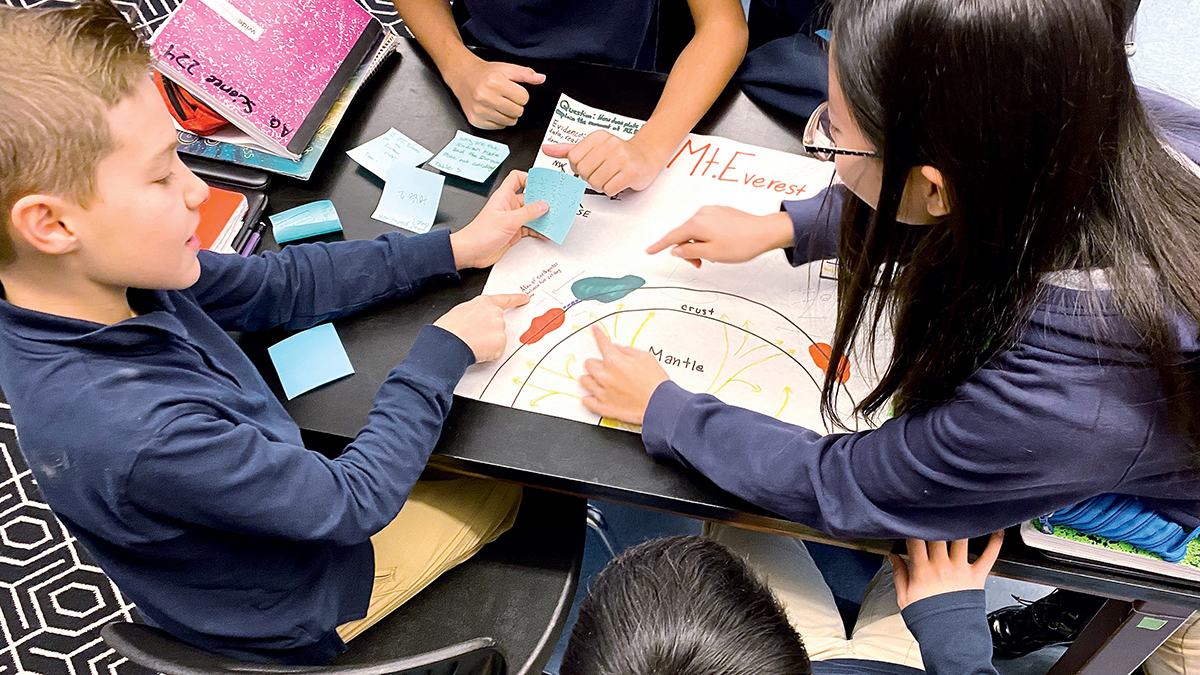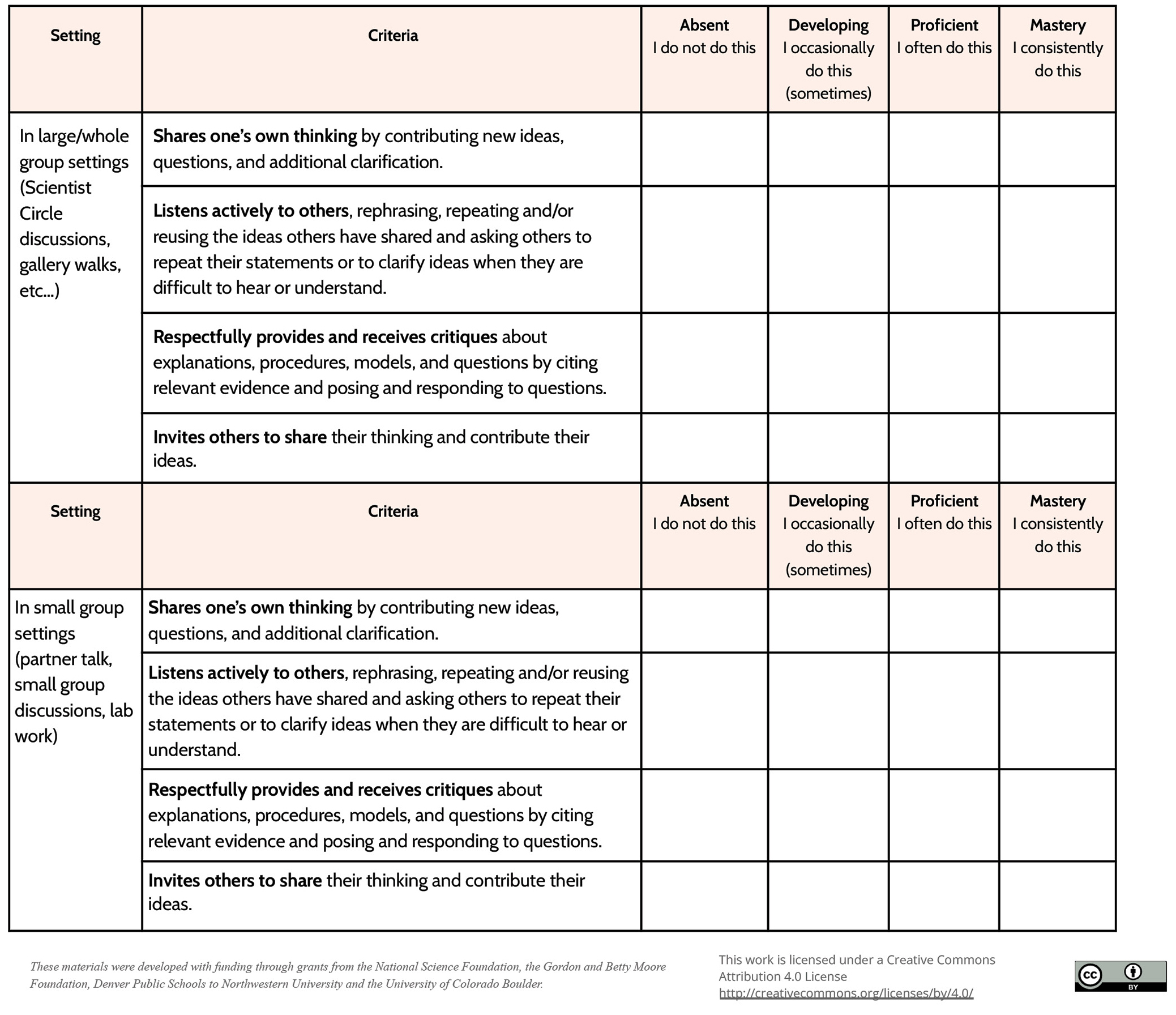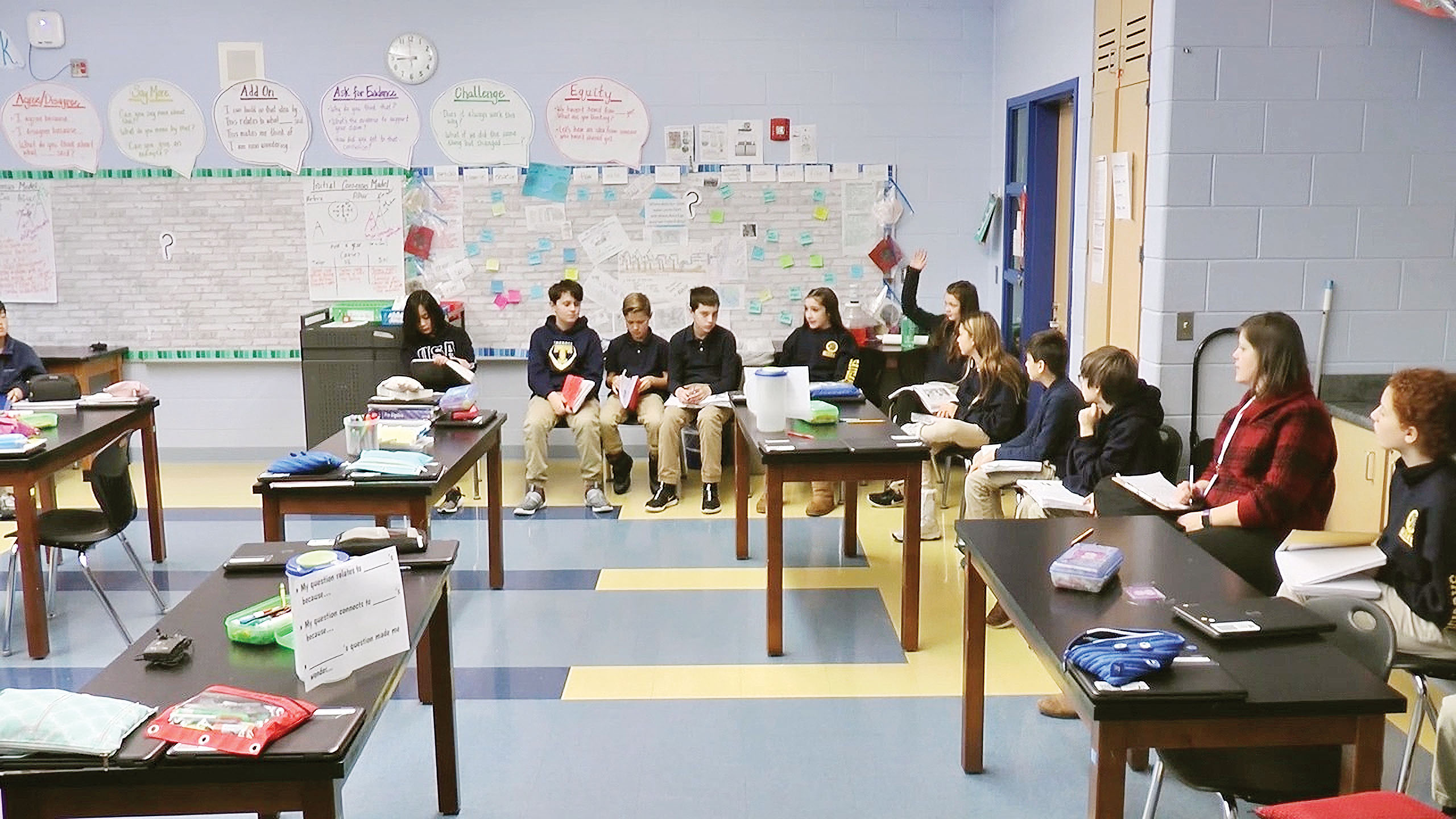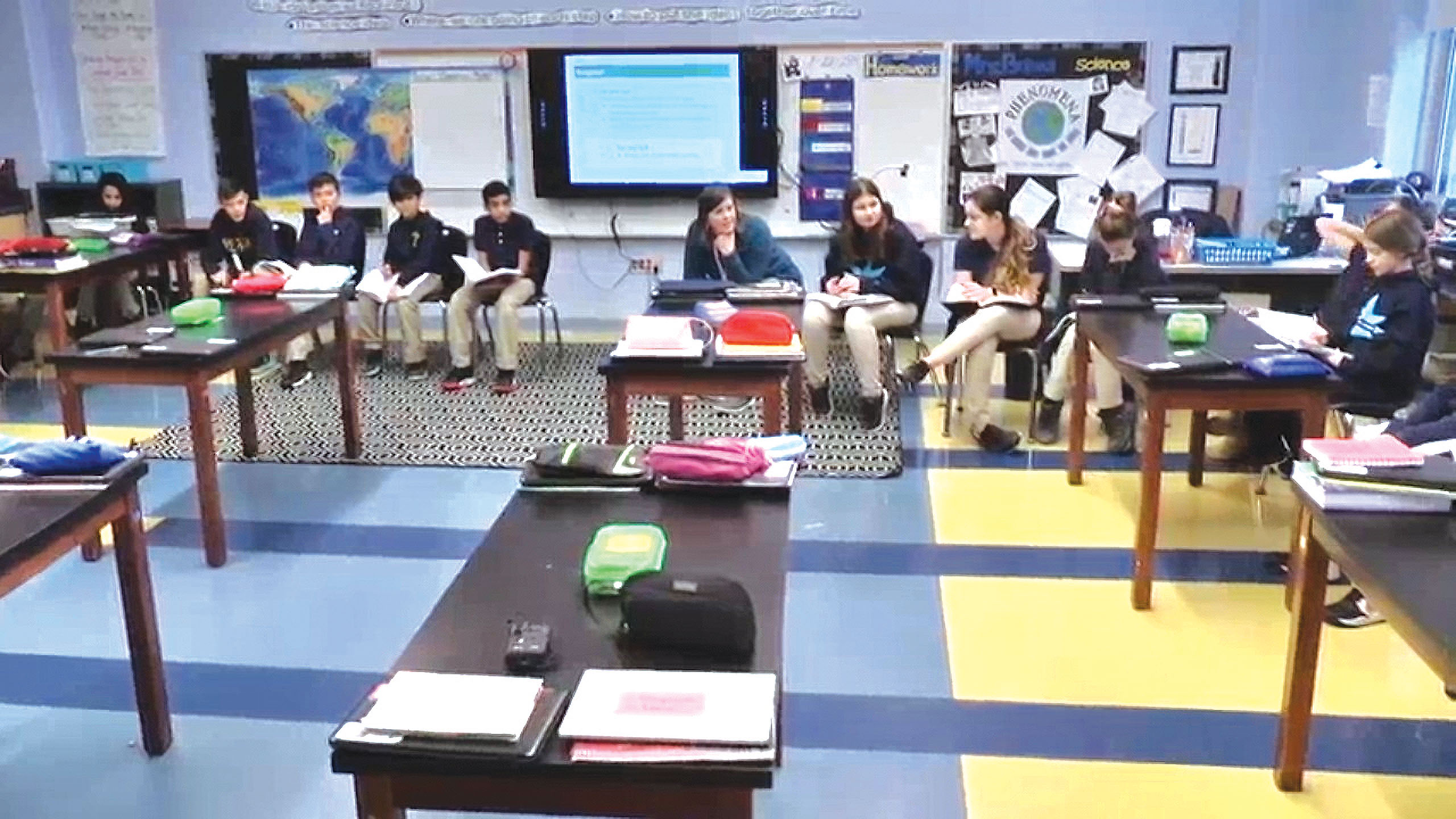feature
Some of You Are Smiling Now
Supporting Trust, Risk Taking, and Equity in Your Classroom
Science Scope—May/June 2022 (Volume 45, Issue 5)
By Renee Affolter, Katherine L. McNeill, and Gretchen Brinza

Ms. B is helping her sixth-grade students share their initial ideas to explain a puzzling phenomenon. Students had recorded noticings and wonderings as they watched two videos and completed a reading that revealed that Mt. Everest is growing vertically, moving northeast 3–4 cm each year, and that it moved backward (southwest) during a recent earthquake. Afterward, students developed individual models to explain how these events could happen and then shared those models with a partner. Ms. B gathered students in a scientist circle and asked them to discuss with a partner any ideas that were puzzling to them (see link to classroom video “Day 1: Make Sense of the Phenomenon—Curriculum Launch PL” in Online Resources).
In the excerpt shown in the box on p. 31 from the OpenSciEd curriculum unit What causes the Earth’s surface to change? [Everest Unit] (Novak and Mohan 2022; see link at end of the reference), we see a classroom culture where students’ initial ideas are viewed as valuable and essential to their work of figuring out phenomena. Students are encouraged to take risks and to work with each other’s ideas as they collaboratively engage in sensemaking. But this work is challenging. What moves did Ms. B use during this discussion? And how did she set up a culture where all students are valued?
Classroom culture to support equitable sensemaking
The Next Generation Science Standards (NGSS Lead States 2013) and A Framework for K–12 Science Education (National Research Council 2012) emphasize an equity vision of science instruction in which all students are known, heard, and supported with access and opportunities for learning as they figure out phenomena. However, too often specific ways of communicating and demonstrating knowledge are valued over others (Bang et al. 2017; Brown 2019). Traditionally, K–12 schools have valued definitions, academic language, and strict turn-taking, thus providing a narrow view of what science looks like and who can do science (Bang et al. 2017). All students have a wealth of experiences, ideas, and language that they bring to their sensemaking and that might not be expressed in academic or scientific language (Brown 2019). Additionally, the teacher or the curriculum is often the sole holder of knowledge in the classroom, which presents a narrow view of what it means to do science. If we want to support an equity vision of science instruction, then we need to start to shift who and what are valued in the classroom.
Figure 1 describes four features of classroom culture that support equitable sensemaking (OpenSciEd; Wingert 2019; see link to Features of Classroom Culture that Support Equitable Sensemaking in Online Resources). First we will briefly describe these features and then identify specific teaching strategies to support them.

Four features of classroom culture (OpenSciEd).
Feature 1: What science is practiced in the classroom?
If we want to establish a classroom culture where we consider all ideas, students need opportunities to observe, wonder, and explain complex phenomena or design solutions. Ms. B engaged in routines around the anchoring phenomenon, an initial phenomenon used to surface student ideas and questions that will then drive future investigations (Reiser et al. 2021). In the discussion excerpt shared in the box, we see three different student ideas (tectonic plates, snow pushing the mountain up, and the mountain getting taller as it moves up a hill) being shared. Ms. B captured all of these ideas on the initial consensus model and noted them with question marks to indicate that the class has lots of questions. By shifting what science is practiced in the classroom from memorization of facts to one organized around phenomena, all students have the opportunity to contribute ideas.
Feature 2: What ways of knowing are privileged in the classroom?
We cannot consider and build on all ideas if students and the teacher do not value the diverse resources that each person brings. Making space for students to use their everyday and native languages for their sensemaking as well as other ways to communicate (e.g., gestures, drawing, storytelling) signals that students’ ideas and experiences are valued. In the excerpt in the box, Ms. B does not privilege ideas that use scientific vocabulary (plate tectonics) over other ideas by pointing out that not everyone has that vocabulary so further investigation may be needed. Additionally, as students were exploring the Everest phenomenon, Ms. B asked students to think of other related situations where the land changed suddenly or more slowly, allowing students to connect to their own stories and experiences.
Feature 3: Who is engaged in (or excluded from) classroom activity?
Participation is equitable when everyone has a chance to share their ideas. Providing multiple arrangements (e.g., pairs, small group, whole group) and modalities (e.g., talking, drawing, gesturing) for students to express their ideas can support all students. In Ms. B’s classroom, students first worked in small groups to discuss their noticing and wonderings about the phenomena and then shared with the whole group. She encouraged students to use their bodies to show what they meant when they discussed the mountain’s movements. Students then were encouraged to use words, pictures, and symbols to develop initial models. Later, when the class began to discuss areas where they agreed and where they still had questions, Ms. B encouraged the use of hand signals in addition to talk.
Feature 4: Who is treated as a “knower” in the classroom?
Central to an equitable learning environment is the need for students to see themselves and other students, rather than just the teacher or the textbook, as knowers. Ms. B intentionally uses “we” to include students as part of a group that is constructing the ideas in the classroom. In a classroom where students are treated as knowers, students share their thinking even if they are not sure it is right. In the excerpt in the box, Ms. B asks students to share a partner’s idea, which removes some of the risk of sharing their own ideas. She also acknowledges that it is OK to be unsure, that our ideas will evolve, and that it is useful to have different ideas. Later in the discussion, Ms. B shows that she values students’ ideas by soliciting how they want to represent their thinking on the class consensus model (“So how do I draw that? How do you guys want me to show this?”).
Instructional strategies to support classroom culture
Next we discuss three strategies and their associated tools to support this classroom culture (see Table 1 for a summary and additional strategies).
Strategy 1: Establish and revisit class norms
Establishing classroom norms is critical in getting students to realize their voices are valued. During the norm-building process, students realize that they must be active participants who listen to, build on, and challenge the ideas of others. Students also know that their job is not only to participate but also to invite others in and consider their tone as they react to others’ ideas.
If we want a classroom culture where all students feel it is safe to participate and productively struggle together, it is important that we devote enough class time to co-constructing norms and revisiting them as we move through the school year. A rigid list of norms given to students with no student input simply becomes a list of classroom rules and not a shared set of norms. One approach to co-constructing the norms is to first explain what norms are and why we need them for productive science talk. Then students can suggest ideas that they think might support their learning. For example, you could ask students what might prevent someone from participating in a discussion. Then brainstorm together agreements the class can make that might help all students feel comfortable sharing ideas. Another option is to provide a set of norms as a starting point. Figure 2 shows a sample set of norms from OpenSciEd that are focused on figuring things out and that encourage students to share ideas in the modes that work for them. Students could discuss what the norms mean in their own words, edit or add further indicators, and give reasons why these norms might help the class as well as identify which norms might feel challenging and why.

Sample classroom norms (OpenSciEd).
Additionally, norms need to be revisited and revised regularly throughout the school year. For example, in addition to checking in as a class (e.g., how did we do today on our norms during the discussion?), you can ask students to select a norm they would like to focus on for the day and share that with a partner. At the end of the day, students can share how they did with their focal norm to help support accountability and growth. Regular check-ins (rather than checking in only when something has gone “wrong” or at the beginning of the year) can help reinforce that this is something we are working toward all year. Additional information around establishing norms can be found in the OpenSciEd resource, Classroom Norms to Support a Culture of Figuring Out (see link in Online Resources).
Strategy 2: Use different activity structures to share ideas
Classroom activities can be structured in different ways to encourage students to share ideas and reduce risk. Table 1 includes three different examples: anonymous share, partner/group share, and scientist circle.
Ms. B: Can somebody share out not what they said was puzzling, but can you share out what your partner said was puzzling about their model? As a way to show that we were absolutely listening to our partners. Eva, go ahead.
Eva: So this was kind of, I had two partners so both of them said this, kind of confusing how the tectonic plates actually worked and like what happened with the tectonic plates.
Ms. B: Okay. Yeah. And to be honest with you, too, that was a fancy word that I’ve heard some people saying, and looking at people’s initial models not everybody had that. So maybe that’s something we have to figure out about too. Great. Thanks for sharing, Eva. Trevor, what did your partner say?
Trevor: I had two partners and Chris said that the snow came down and then it would push the mountain up because it would all catch at the bottom.
Ms. B: Okay.
Trevor: And then Danny said that it would be raised as the mountain was moving. So like the mountain might go up a hill, and that’s how it would get taller.
Ms. B: Interesting. Those seem like different ideas. Right. [Danny and Chris quietly laughing.] And that’s interesting and puzzling too, right? And I see you guys laughing, why are you laughing?
Chris: ‘Cause the ideas are not the best.
Ms. B: Hold on a second, but we have to recognize, I don’t think anybody at this point, right, really knows how this works. We have a lot of questions about that. And even though your ideas are different, are different ideas in our classroom okay?
Students: Yeah.
Ms. B: Yeah. I mean, I think back to our thermal energy unit. None of us considered particle collisions at the beginning, and at the end we were laughing about where we had gone, right? So it’s totally okay. Some of you are smiling now. It’s totally okay to have these ideas, right? So thank you for sharing, okay.
Instructional strategies to support equitable sensemaking.
|
Establish and revisit class norms |
|
|
Use different activity structures to share ideas |
|
|
Support discussion with talk moves |
|
|
Connect to students’ lives and experiences |
|
|
Support different forms of participation |
|
The excerpt in the box included both a partner/group share and a scientist circle. In a partner/group share, students share ideas with others in a pair or small group. As ideas are shared out publicly to the whole group, students aren’t allowed to share their own ideas, but rather the ideas they heard from someone else. This removes the ownership of an idea that may be controversial. It also promotes active listening, as students will have to share an idea from someone else. A scientist circle involves students sitting in a circle so they can see and speak directly to each other. This shifts the focus from the teacher and signals that we all need to contribute to make sense. In addition, Ms. B also used an anonymous share where she would collect student work (i.e., initial models), select a diverse group of competing ideas, and share anonymously. This can occur through a digital platform (i.e., Google Drawing), through students submitting a photo of their work in a LMS (e.g. Google Classroom or Moodle), or through teacher picture taking (or making copies and omitting names) and sharing. When using this activity structure, it is important to have a conversation ahead of time about what happens if a student sees their own work to ensure that no one’s ideas are identified (e.g., assign a number to reference each idea).
Strategy 3: Support discussion with talk moves
Carefully facilitated discussions that surface and value student ideas can position students as thinkers and holders of ideas rather than just trying to get the right answer. However, to support these discussions, students need to (1) be willing to share their ideas, (2) listen carefully to others, (3) deepen their own reasoning, and (4) work with others’ ideas (Michaels and O’Connor 2012). The Inquiry Project’s “talk moves” are specific strategies and questions that help support these four goals and are shown in the Inquiry Project’s “Talk Moves Checklist” (see link in Online Resources). For example, during the initial consensus model discussion, we see Ms. B ask for someone to restate what a student is saying:
Caleb: So you draw one picture with the mountain here and then like another one with the mountain here and so on and so forth, I guess.
Teacher: What’s he saying? Mountain here [points to the chart paper]? Another mountain here?
Andrea: Before and after?
Teacher: Go ahead.
Andrea: Like the before and the after effect.
Teacher: Is that what you mean, Caleb? How do we feel about that? Before and . . . Yes? No?
Caleb/Students: Mm-hmm [affirmative].
This “restate” talk move (e.g., What’s he saying?) supports students in listening carefully to each other (Goal 2). It is important to note that Ms. B checks in with Caleb to make sure that Andrea has restated his idea correctly. This signals to the class and to Caleb that his idea is important. In addition to teachers using talk moves, students can self-assess their engagement in discussions using a tool like the one from OpenSciEd shown in Figure 3. These self-assessments could provide valuable information for the teacher regarding how each individual student feels as they are engaging in discussions—an important aspect of classroom culture. They also bring awareness to the student for their own personal growth, such as “Can I share more of my ideas next time? How can I more appropriately respond when a classmate argues with my idea? I noticed _____ didn’t say anything all throughout the scientist circle—should I ask them what they’re thinking next time?” The teacher could collect these self-assessments and then use the information formatively to guide them in how to support individual students as well as the class as a whole (see Online Resources for link to OpenSciEd Teacher Tools & Resources).

Student self-evaluation for classroom discussions (OpenSciEd).

Students in Ms. B’s class share questions as they build their Driving Question Board.
Photo courtesy of David Stockton
Conclusion
Supporting trust, risk taking, and equity in a middle school classroom is challenging, but it is essential for scientific sensemaking. The four features of equitable classroom culture highlight a focus on both what and who is valued in classrooms. The instructional strategies offer suggestions on ways to support these four elements to create instructional moments like Ms. B’s classroom, in which students offer ideas even when they are worried that “the ideas are not the best” because Ms. B has created a classroom where all ideas are valued and “we” figure it out together. •

Students in Ms. B’s class gather in a scientist circle to discuss their initial ideas.
Photo courtesy of David Stockton
Online Resources
Day 1: Make Sense of the Phenomenon—Curriculum Launch PL—https://bit.ly/3tdKeXg
OpenSciEd: Classroom Norms to Support a Culture of Figuring Out—https://bit.ly/3tNNuJ6
OpenSciEd: Features of Classroom Culture that Support Equitable Sensemaking—https://bit.ly/3JkvMCf
OpenSciEd: Teacher Tools & Resources—https://www.openscied.org/teacher-resources/
Self-Documentation Instructional Technique—http://stemteachingtools.org/sp/self-doc
Talk Moves Checklist—https://bit.ly/3sYKNDX
Renee Affolter (affolter@bc.edu) is the Co-Director for the OEI Initiative and Katherine L. McNeill is a professor of science education, both in the Lynch School of Education at Boston College in Chestnut Hill, Massachusetts. Gretchen Brinza is a middle school science teacher at Louisville Middle School in Louisville, Colorado.
Equity Professional Learning Sensemaking Teacher Preparation Teaching Strategies Middle School


